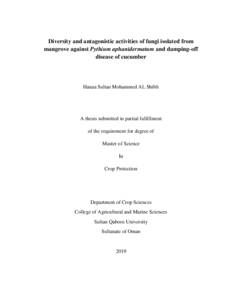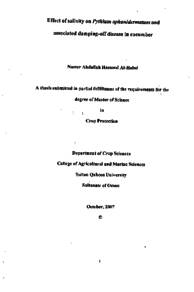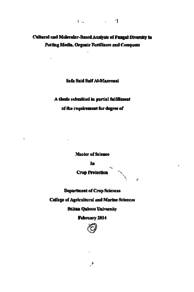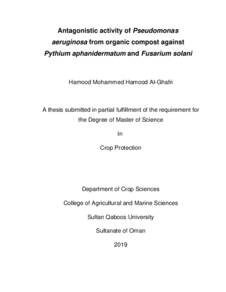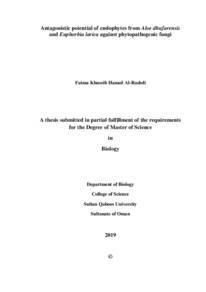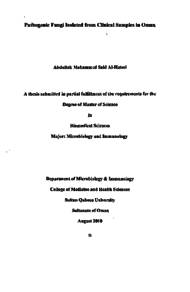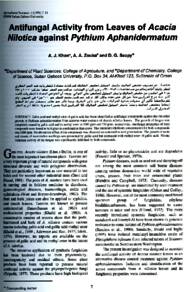Document
Diversity and antagonistic activities of fungi isolated from mangrove against Pythium aphanidermatum and damping-off disease of cucumber
Publisher
Sultan Qaboos University
Gregorian
2019
Language
English
English abstract
A study was conducted to investigate fungal diversity in mangrove (Avicennia marina) and the potential of fungal isolates obtained from mangrove in inhibiting Pythium aphanidermatum and damping-off disease of cucumber. MiSeq analysis of fungal diversity in mangrove roots, stems and leaves showed that the three parts have a relatively high level of fungal diversity. Ascomycota was the most dominant phylum in all the parts, with Aspergillus, Fusarium and Cladosporium being the most dominant fungal genera. Detection of fungi in mangrove roots, stems and leaves using culture-based techniques showed that Aspergillus and Fusarium were the most dominant isolates on mangrove roots. Six, one and no fungal genera were detected in mangrove roots, stems and leaves, respectively. MiSeq analysis detected more fungal genera in mangrove compared to culture-based techniques, which could be related to the ability of MiSeq analysis to detect slow growing as well as obligate fungal species.Testing the antagonistic activity of ten fungal isolates from mangrove against Pythium aphanidermatum showed that one isolate exhibited in vitro inhibition of P. aphanidermatum growth. Electron microscope examination revealed that the antagonistic fungal isolate resulted in shrinking and groves in Pythium hypha. The fungal isolate was identified as Aspergillus terreus. When A. terreus culture filtrate was added to P. aphanidermatum, it resulted in a significant increase (by 73%) in electrolyte leakage from Pythium hypha compared to the control, as well as significant reduction (by 71%) in oospore production. The A. terreus culture was also found to produce cellulase enzyme, which is suggested to be involved in the antagonism against P. aphanidermatum. Adding A. terreus to soil infested with P. aphanidermatum significantly reduced percent mortality in cucumber seedlings by 70%. A. terreus, when applied alone on cucumber seedlings, did not show any suppressive effects on cucumber growth (length and fresh and dry weight). This appears to be the first report of isolation of A. terreus from mangrove with antagonistic activity against P. aphanidermatum-induced damping-off of cucumber. The study indicates that fungal isolates obtained from marine environments may serve as potential biocontrol agents against some plant pathogens.
Description
Thesis
Member of
Resource URL
Arabic abstract
أجريت دراسة لاستقصاء التنوع الفطري في أشجار المانغروف (Avicennia marina) البحري ودراسة قدرة العزلات الفطرية التي تم الحصول عليها من المانغروف في تثبيط البيثيوم ) Pythium aphanidermatum ( المسبب لمرض موت البادرات في الخيار، حيث أظهر تحليل MiSeq للتنوع الفطري في جذور المنغروف والسيقان والأوراق أن الأجزاء الثلاثة لديها مستوى عال نسبيا من التنوع الفطري. كانت أسكوميكوتا (Ascomycota) هي الفئة الأكثر هيمنة في جميع الأجزاء، ووجد أن أسبيرجيلوس وفيوساريوم وكلادوسبوريوم أكثر الأنواع الفطرية تواجدا في المانغروف. أظهر عزل الفطريات من جذور المنغروف والسيقان والأوراق أن أسبرجيلس وفيوزاريوم هما الأكثر انتشارا على جذور المنغروف، وتم الكشف عن ستة اجناس من الفطريات في جذور المانغروف وواحد في السيقان بينما لم يتم عزل أي فطر من الأوراق. اكتشف تحليل MiSeq أجناس فطرية أكثر في المنغروف مقارنة بالتقنيات القائمة على العزل، والذي يمكن أن يعزى الى قدرة تحليل MiSeq على اكتشاف أنواع فطرية بطيئة النمو وكذلك بعض الأنواع الفطرية التي لا تنمو على الأوساط الغذائية الصناعية .
أظهر اختبار عشرة عزلات فطرية من المانغروف ضد Pythium aphanidermatum أن إحدى العزلات لها قدرة كبيرة في تثبيط نمو البيثيوم، وكشف فحص المجهر الإلكتروني أن العزلة الفطرية المضادة أدت إلى تقلص هيفات Pythium aphanidermatum . وأظهر التحليل أن العزلة الفطرية هي Aspergillus terreus ، وعند اضافة مستخلص فطر Aspergillus terreus الى Pythium aphanidermatum أدى ذلك إلى زيادة كبيرة )بنسبة 73%( في تسرب المحلول من هيفات البيثيوم ، وكذلك انخفاض كبير )بنسبة 71 ٪( في إنتاج الأبواغ كما وجد أن فطرAspergillus terreus ينتج إنزيم السليلاز والذي يمكن أن يكون له تأثير مباشر على Pythium aphanidermatum ،كم أدت إضافة Aspergillus terreus إلى التربة الملوثة ب Pythium aphanidermatum إلى انخفاض كبير في معدل الموت في شتلات الخيار بنسبة 70 ٪، بينما لم يكن هناك أي تأثير سلبي لفطر Aspergillus terreus على نمو الخيار. تعد هذه الدراسة الأولى التي تبين عزل Aspergillus terreus من المانغروف والذي يتصف بخاصية تثبيط ضد مرض موت البادرات في الخيار. تشير الدراسة إلى أن العزلات الفطرية التي تم الحصول عليها من البيئات البحرية قد تكون لها استخدامات مستقبلية ضد بعض مسببات الأمراض النباتية
أظهر اختبار عشرة عزلات فطرية من المانغروف ضد Pythium aphanidermatum أن إحدى العزلات لها قدرة كبيرة في تثبيط نمو البيثيوم، وكشف فحص المجهر الإلكتروني أن العزلة الفطرية المضادة أدت إلى تقلص هيفات Pythium aphanidermatum . وأظهر التحليل أن العزلة الفطرية هي Aspergillus terreus ، وعند اضافة مستخلص فطر Aspergillus terreus الى Pythium aphanidermatum أدى ذلك إلى زيادة كبيرة )بنسبة 73%( في تسرب المحلول من هيفات البيثيوم ، وكذلك انخفاض كبير )بنسبة 71 ٪( في إنتاج الأبواغ كما وجد أن فطرAspergillus terreus ينتج إنزيم السليلاز والذي يمكن أن يكون له تأثير مباشر على Pythium aphanidermatum ،كم أدت إضافة Aspergillus terreus إلى التربة الملوثة ب Pythium aphanidermatum إلى انخفاض كبير في معدل الموت في شتلات الخيار بنسبة 70 ٪، بينما لم يكن هناك أي تأثير سلبي لفطر Aspergillus terreus على نمو الخيار. تعد هذه الدراسة الأولى التي تبين عزل Aspergillus terreus من المانغروف والذي يتصف بخاصية تثبيط ضد مرض موت البادرات في الخيار. تشير الدراسة إلى أن العزلات الفطرية التي تم الحصول عليها من البيئات البحرية قد تكون لها استخدامات مستقبلية ضد بعض مسببات الأمراض النباتية
Category
Theses and Dissertations

